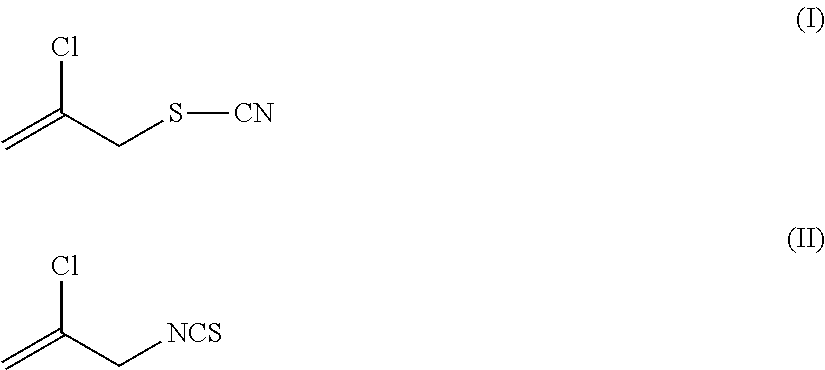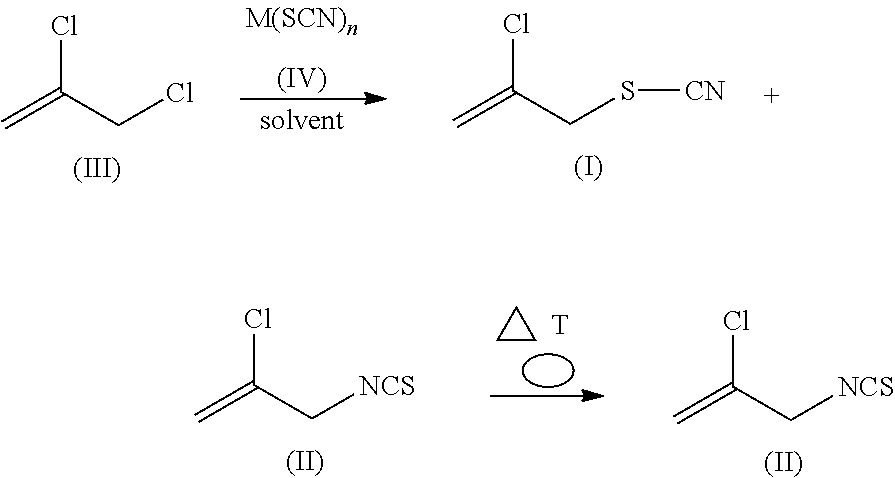Method for producing 2-chloroallyl thiocyanate and 2-chloroallyl isothiocyanate
a technology of chloroallyl thiocyanate and isothiocyanate, which is applied in the field of 2chloroallyl thiocyanate and 2chloroallyl isothiocyanate, can solve the problems of disadvantageous industrial process use of diluents, reaction rate, and prolonging reaction time required
- Summary
- Abstract
- Description
- Claims
- Application Information
AI Technical Summary
Benefits of technology
Problems solved by technology
Method used
Image
Examples
example 1
[0053]Technical-grade 2,3-dichloro-1-propene (496.5 g) (GC analysis: 89.4% purity; water (KF): 0.45%) is used as initial charge in a 2-liter jacketed reaction vessel with stirrer and reflux condenser, and is heated to 70° C. At this temperature, 165.46 g of sodium thiocyanate (98% purity) are added in three portions, with stirring. The mixture is then heated to 80° C., and is stirred for 90 minutes at the said temperature, and cooled back to 70° C., and 500 ml of water are added. The organic phase is separated off at room temperature. This gives 530.3 g of organic phase, which according to GC analysis comprises 41.8 percent by area of 2,3-dichloro-1-propene, 24.9 percent by area of 2-chloroallyl thiocyanate of the formula (I) and 24.5 percent by area of 2-chloroallyl isothiocyanate of the formula (II).
[0054]This organic phase is distilled at 250 mbar until the bath temperature reaches 75° C. This gives 212.7 g of distillate with, according to GC analysis, 207.6 g of 2,3-dichloro-1-p...
example 2
[0056]Distilled 2,3-dichloro-1-propene (150 g) (GC analysis: 97.3% purity; water (KF): <0.1%) is mixed for 30 minutes with 6 g of Aliquat® 336 and 50 ml of water, and the phases are then separated. This pretreated 2,3-dichloro-1-propene (water (KF): 0.6%) is used as initial charge together with 333.3 g of technical-grade 2,3-dichloro-1-propene (GC analysis: 89.4% purity; water (KF): 0.45%) in a 2 liter jacketed reaction vessel with stirrer and reflux condenser. Sodium thiocyanate (165.46 g) (98% purity) is then added, with stirring. The mixture is then heated to 80° C., stirred for two hours at the said temperature, and cooled back to 70° C., and 500 ml of water are added. The organic phase is separated off at room temperature. This gives 512.4 g of organic phase, which according to GC analysis comprises 44.2 percent by area of 2,3-dichloro-1-propene, 20 percent by area of 2-chloroallyl thiocyanate of the formula (I) and 27.9 percent by area of 2-chloroallyl isothiocyanate of the fo...
example 3
[0059]Technical-grade 2,3-dichloro-1-propene (495.4 g) (GC analysis: 89.6% purity; water (KF): 0.45%) is used as initial charge in a 2-liter jacketed reaction vessel with stirrer and reflux condenser, and is heated to 70° C. At this temperature, 155.35 g of ammonium thiocyanate (98% purity) are added in two portions, with stirring. The mixture is then heated to 80° C., and is stirred for two hours at the said temperature, and cooled back to 70° C., and 500 ml of water are added. The organic phase is separated off at room temperature. This gives 514.9 g of organic phase, which according to GC analysis comprises 58.8 percent by area of 2,3-dichloro-1-propene, 13.8 percent by area of 2-chloroallyl thiocyanate of the formula (I) and 19.05 percent by area of 2-chloroallyl isothiocyanate of the formula (II). This gives a yield of 99% of theory, based on reacted 2,3-dichloro-1-propene.
PUM
| Property | Measurement | Unit |
|---|---|---|
| Temperature | aaaaa | aaaaa |
| Percent by mass | aaaaa | aaaaa |
| Percent by mass | aaaaa | aaaaa |
Abstract
Description
Claims
Application Information
 Login to View More
Login to View More - R&D
- Intellectual Property
- Life Sciences
- Materials
- Tech Scout
- Unparalleled Data Quality
- Higher Quality Content
- 60% Fewer Hallucinations
Browse by: Latest US Patents, China's latest patents, Technical Efficacy Thesaurus, Application Domain, Technology Topic, Popular Technical Reports.
© 2025 PatSnap. All rights reserved.Legal|Privacy policy|Modern Slavery Act Transparency Statement|Sitemap|About US| Contact US: help@patsnap.com



